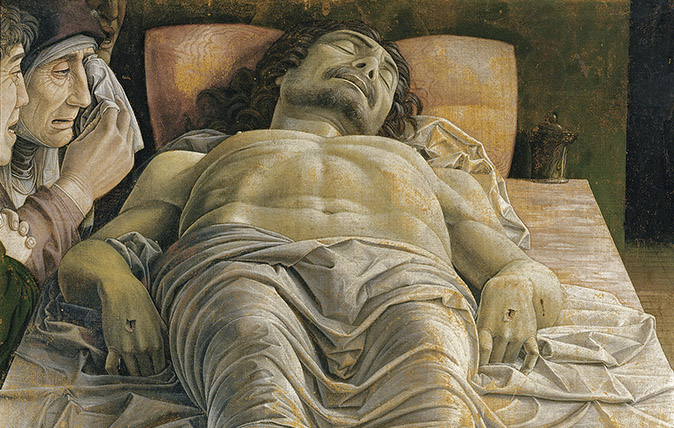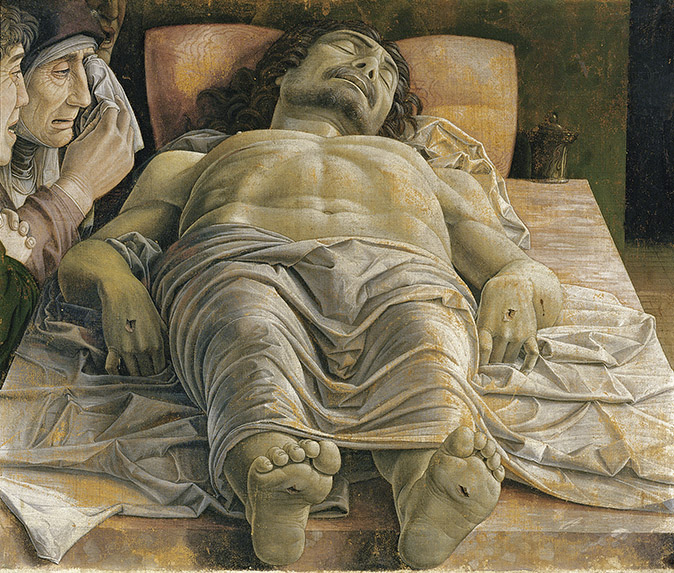My favourite painting: Jeremy Vine
'I feel sure I’ve seen it on the cover of a Joy Division record.'



Lamentation of Christ, about 1480, by Andrea Mantegna (1431–1506), 26½in by 32in, Pinacoteca di Brera, Milan, Italy
Jeremy Vine says: Consider the following: this picture only emerged when Mantegna died – his sons found it in his studio and sold it to pay off debts. We now see it as a major moment in art, with dramatic use of perspective applied to the human body. The foreshortening makes the genitals of Christ central to the painting and the feet and hands bigger than the face. I “discovered” the picture myself when my daughter and I studied a little art history together. I feel sure I’ve seen it on the cover of a Joy Division record. Although most early religious art looks kitsch now, this is very real and brutal.
Jeremy Vine is a broadcaster and journalist known for his Radio 2 show and presenting Eggheads. His new book, What I Learnt, was published last week.
John McEwen comments on Lamentation of Christ: Padua has a stone-like sound, which is appropriate for its famous son, Andrea Mantegna, described by the late Sir Michael Levey as having a ‘nature to expose and then petrify each object, plotting its place in the scheme’. He liked to include stone in all its forms in his paintings and the Lamentation is no exception with its marble slab, Christ’s corpse a reminder that, in death, we are turned to stone.
Mantegna was the son of a country carpenter, his social ascent described by Vasari as that of ‘an artist who was born of very humble stock and yet rising to the rank of a knight through his own efforts and good fortune’. He was lucky to grow up in Padua, with its famous university and Roman past as Patavium, a pride in history that resisted the humiliation of annexation by Venice in 1405. Paduans made much of their civic antiquity. A tomb erected in 1283 was said to contain the bones of their founder, the Trojan Antenor.
Clever, witty, ambitious and artistically outstanding, the young Mantegna made the most of these intellectual opportunities. Antiquarians and ‘humanists’ dedicated to Classical literature fostered a fascination for Classical art, which his master, Francesco Squarcione, encouraged by making him draw antique statuary. Contact with mathematicians and natural philosophers may explain his obsession with the novel art of geometrically based perspective and the need for unflinching naturalism.
The Lamentation exemplifies both extreme perspective and searing naturalism: Christ human even to his manhood, the mourners – supposedly St John the Evangelist, Mary and Mary Magdalene (with a contorted mouth) – stricken.
Exquisite houses, the beauty of Nature, and how to get the most from your life, straight to your inbox.
Country Life is unlike any other magazine: the only glossy weekly on the newsstand and the only magazine that has been guest-edited by His Majesty The King not once, but twice. It is a celebration of modern rural life and all its diverse joys and pleasures — that was first published in Queen Victoria's Diamond Jubilee year. Our eclectic mixture of witty and informative content — from the most up-to-date property news and commentary and a coveted glimpse inside some of the UK's best houses and gardens, to gardening, the arts and interior design, written by experts in their field — still cannot be found in print or online, anywhere else.
